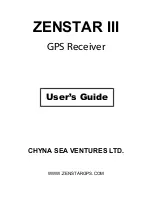
190-01263-01 Rev. A
Garmin G2000 Pilot’s Guide for the Cessna T240
37
SyStem Overview
Sy
Stem
O
ver
view
FL
iGH
t
iNS
tr
Ume
N
tS
ei
S
AUD
iO P
AN
eL
& CNS
FL
iGH
t
m
ANA
G
eme
N
t
HAZA
rD
Av
O
iD
ANC
e
AFCS
ADD
iti
ONAL
Fe
At
Ure
S
APP
eND
iC
eS
iND
eX
SY
STEM
O
VER
VIEW
FLIGHT
INSTRUMENTS
EIS
AUDIO & CNS
FLIGHT
MANA
GEMENT
HAZARD
AV
OID
ANCE
AFCS
ADDITIONAL
FEA
TURES
APPENDICES
INDEX
GPS INPUT FAILURE
note:
In-flight initialization of AHRS, when operating without any valid source of GPS data and at true
air speed values greater than approximately 200 knots, is not guaranteed. Under these rare conditions, it
is possible for in-flight AHRS initialization to take an indefinite amount of time which would result in an
extended period of time where valid AHRS outputs are unavailable.
Two GPS inputs are provided to the AHRS. If GPS information from one of the inputs fails, the AHRS uses
the operating GPS input and an alert message is issued to inform the flight crew. If both GPS inputs fail, the
AHRS can continue to provide attitude and heading information to the PFD as long as magnetometer and
airspeed data are available and valid.
MAGNETOMETER FAILURE
If the magnetometer input fails, the AHRS transitions to one of the reversionary No-Magnetometer modes and
continues to output valid attitude information. However, if the aircraft is airborne, the heading output on the
PFD does become invalid (as indicated by a red “X”).
AIR DATA INPUT FAILURE
Failure of the air data input has no affect on the AHRS output while AHRS is receiving valid GPS
information. Invalid/unavailable airspeed data in addition to GPS failure results in loss of all attitude and
heading information.
GpS receiver operation
Each GIA 63W Integrated Avionics Unit (IAU) contains a GPS receiver. Information collected by the specified
receiver (GPS 1 for the #1 IAU or GPS 2 for the #2 IAU) may be viewed on the GPS 1 or GPS 2 STATUS Pane
and the GPS Status Screen on the Touchscreen Controller (refer to Figure 1-29).
These GPS sensor annunciations are most often seen after system power-up when one GPS receiver has
acquired satellites before the other, or one of the GPS receivers has not yet acquired an SBAS (Satellite Based
Augmentation System) signal. While the aircraft is on the ground, the SBAS signal may be blocked by
obstructions causing one GPS receiver to have difficulty acquiring a good signal. Also, while airborne, turning
the aircraft may result in one of the GPS receivers temporarily losing the SBAS signal.
If the sensor annunciation persists, check for a system failure message by touching the
MSG
Button on
Touchscreen Controller. If no failure message exists, check the GPS Status Screen and compare the information
for GPS 1 and GPS 2. Discrepancies may indicate a problem.
This manual downloaded from http://www.manualowl.com















































